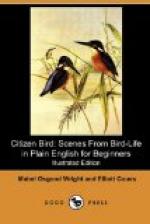“Though this Grosbeak seems rather dull and stupid out of doors, he is a charming cage pet, growing tame and singing a delightful warbling song. I picked up one with a broken wing when I was a boy, and kept him for many years; the hurt wing was soon healed, and the bird was always tame and happy after that, though he soon lost his bright feathers. But I would never advise any one to make a cage pet of a bird who has been born wild and once known liberty. No matter if he lives and thrives: he will sometimes remember the days when he was free, and be very sad.” “My Canary is never sad,” said Nat: “he is always singing.”
“For very many years Canaries have been bred in cages, to be pets, and as these have never been wild they are used to cage life. They are the best birds for pets, because they are seed-eaters, and it is easy to supply the food they like.
“Some winter day, or even late in autumn, you may see on your walks, another red bird—a near relation of the Pine Grosbeak; in fact, the two often flock together. This bird is called the American Crossbill.”
The Pine Grosbeak
Length about nine inches.
General color of adult male strawberry-red, the wings and tail dark, with some light-brown and white edgings; the tail forked a little.
The female and young male gray, tinged here and there with saffron-yellow.
A Summer Citizen as far north from the States as trees grow, roving in winter about the northerly and middle States.
A fine, large Weed Warrior, with a very stout beak, almost like a Parrot’s.
THE AMERICAN CROSSBILL
(THE CONE WRENCHER)
“When it is winter in the northern parts of North America, and the Great Snow Owls have scattered on their southward journey—when heavy snows have beaten down and covered the seed-stalks of weeds and well-nigh walled the little fur-bearing beasts into their holes—then in regions where March brings only storms of sleet to coat the tree-trunks and lock up insect food, a pair of strange birds are already building their nest.
“These two birds, though alike in shape, are as different in color as Mr. and Mrs. Scarlet Tanager. But there is one point about them by which you may tell them from any others. Their curving bills are crossed at the tip, which strange arrangement gives them their name of Crossbill. At a little distance you might mistake them for Paroquets, but only the upper half of a Paroquet’s beak is curved, and it closes over the under half; while both parts of the Crossbill’s beak are curved, and they cross each other at the tip like a pair of scissors that do not close properly.
[Illustration: American Crossbill]
“How and where do you think these birds build their nests in such a cold season?”
“Make a burrow in the snow, perhaps,” said Dodo.
“Go into a haystack or under a shed,” said Nat.




